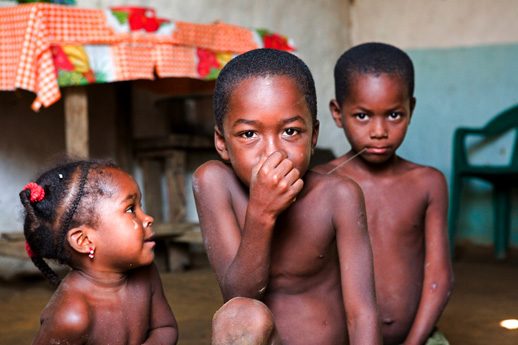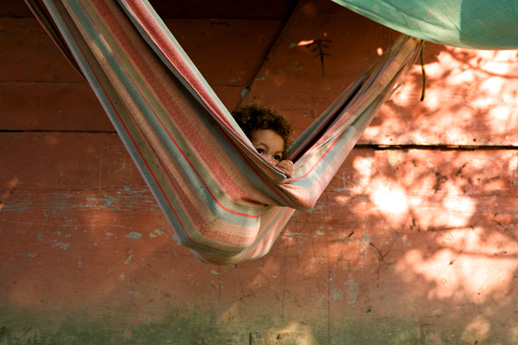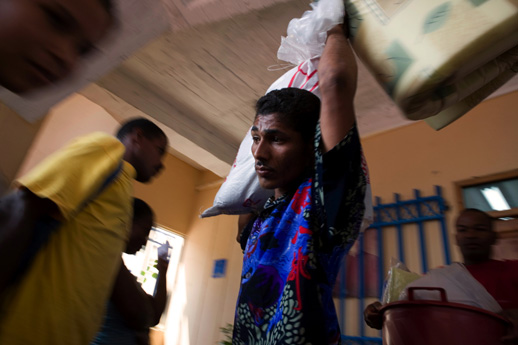The Solitude of Colombia: Stories of Forced Displacement
Tokyo: An urban scrawl and one of the most image saturated cities in the world. Amidst the vast array of flashing lights and multiple TV screens, the UN University Gallery plays host to the work of Tokyo-based Colombian Artist Tomas Reyes. The Exhibition opened on World Refugee Day and is one of a series of events organised by the UNHCR . Reyes presents us with a unique opportunity to take a deeper look into the lives of ‘Other’ people, in this case Colombians who have been forcefully displaced. I caught up with him just before the exhibition’s opening.

You’ve been based in Japan for three years, what drew you to coming here?
I wanted to come to a first world country that was not in Europe, that was not in the West and Japan seemed like a good choice. If I had gone to China or Cambodia it would have been closer to Latin America but Japan is a whole different world.
How much has living here influenced your thinking or ideas?
A lot, because you always look at yourself through the eyes of others; whenever I travel I have a different perception of all the places I have been to not only my home country. Whenever I go back to Colombia I have a different perception of Colombia, and when I come back to Japan I have a different picture of Japan.
How did you first become interested in Art?
I was always interested in Conceptual Art, text and language. During my studies I was considering whether I wanted to put my work into a gallery or Museum or in another context. I have become more and more interested in documentary work and development in the last few years.
How would you place your work now? Do you consider it more Reportage or Art?
Reportage. The Art would be what I do with it: how I put up an exhibition – how I put together all the ideas – not only the captions but the deeper text. To me an exhibition is the possibility to communicate with others. You have a space on which a given audience can actually ‘walk’ through your thoughts. There is a great deal of reflection in the process of creating and then subsequently displaying the work. In this exhibition another question became apparent: what is going to happen after the exhibition?
To me the work of a lot of photojournalists is much more a form of Art than what many people today may consider traditionally consider ‘Art’ . It is a matter of perception and intention. In Europe and the United States, galleries are starting to wake up to this and exhibit the work of Agency Photojournalists. This opens up spaces to communicate to a whole new audience

So, you see documentary style exhibitions as a natural progression of your work?
A few years ago I did experimental video, so I would travel, record sound, take notes, draw and put together videos with hardly any images, just sound and scanned images of my notebook, like a journal. People would come into my exhibition and watch a video installation. I’m doing exactly the same thing but with many more images and images that are more directly related to humanitarian issues.
Today I like to do work that’s on the border of art/documentary journalism. Whenever I did experimental videos before, they were also experimental diaries connecting cultures. I have always been fascinated by the idea of Otherness.
Your images heavily feature people, would you say that human subjects are the primary focus of your photography?
I’m interested in human beings and the situations they live in; how they live and their emotions, their passions, frustrations, sorrows and happiness and how they feel about life. The reason I love working with people and doing documentary photography is that it allows me to tell stories of others to different audiences around the world.
How did the UN exhibition come about?
In late January I went to a film screening of a BBC film about Rwanda called Shooting Dogs. Before the film started the UNHCR screened two videos about the Sudan and Colombia. At the end of the film, everybody remembered the Sudan images, but hardly anyone remembered that they had also just seen a UNHCR video reportage about Colombia. The Colombian IDP (International Displaced Person) crisis is the second largest after Sudan. There are about six million IDPs in the Sudan and four million in Colombia. It has been voted by Doctors Without Borders in the top ten under-reported crises of the last six years. So I thought, I’m Colombian, I’m here, I could go…

How much responsibility do you feel towards the subjects of your photographs?
I feel a huge responsibility towards them. We are trying to put together an NGO in Colombia and work with minorities to devise workable communication strategies for them because they don’t have a voice. In a village called Palenque de San Basilio, the direct descendants of 17th century African enslaved people who liberated themselves have not only survived but developed a rich and unique social and oral tradition which has been granted the title of ‘Masterpiece of the Oral and Intangible Heritage of Humanity’ by UNESCO, and yet their very existence is threatened by Paramilitaries and Guerrillas who are displacing millions of people. The Palenqueros told me at first that they did not want any pictures. Photographers usually come to Palenque to take their exotic portrait and then sell it in galleries of the capital, Bogota, without doing anything for them.
I aspire to give a voice and human face to the Colombian civilians who are caught in the midst of this brutal conflict, and have not been given an extensive visual representation worldwide. I also hope to document the complex faces of forced displacement and its rural and urban aftermath, where IDPs undergo long-lasting phases of traumatic adaptation.
My perception is that the exhibition has a strong anthropological aspect to it, would you agree?
Yes, you could say so. You arrive and see a picture of three Afro-Colombian children and then two maps of Colombia showing what is going on, where the conflict is taking place. Then, as you walk through the exhibit, you see on the photographs and the multimedia video where these people are going – how displacement works – and you the testimonies displayed with the images, illustrating the several phases of forced displacement both in the rural and the urban contexts. This exhibition is about ‘who a Colombian is’. Hopefully I can take it to Colombia afterwards because Colombians need to know more about each other as well.
What would you like viewers to take away from the experience of visiting your work?
Curiosity. And a spark of interest for others. Hardly anyone knows anything about Colombia so it is an extraordinary opportunity to have this exhibition here in Japan at the UN University Gallery. I think it is very important to stimulate people’s interest in others. If people get interested in knowing more about someone else, in this case Colombia, then there is always hope.
To quote from the exhibition text I wrote: “I believe that this project can not only raise National and International Awareness, but can also become an instrument to positively mobilize people against this war”…
Rachel Carvosso
Rachel Carvosso



